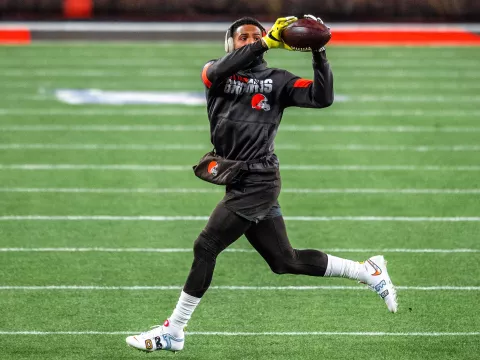- AdventHealth

The Cleveland Browns may have come out on top against the Cincinnati Bengals recently, but the Browns suffered a setback as star wide receiver Odell Beckham Jr. injured his left knee, tearing his ACL. He will now be out for the rest of the season.
In what was just the second snap of the game, Browns’ quarterback Baker Mayfield tried to force a throw to Beckham, but it was intercepted by Cincinnati. When Beckham turned to chase his opponent, he crashed into him (along with the fullback from his own team) while both tried to make the tackle.
Beckham didn’t return to the game, and the next morning had an MRI scan to confirm that he tore the ACL in his left knee. Here’s why this sports injury is so common — and why surgery is usually required to heal.
What is an ACL Injury?
The anterior cruciate ligament, also known as the ACL, is one of the major ligaments in the knee. Ligaments are bands of tissue that connect bones, so your ACL connects the thighbone to the shinbone and helps stabilize the knee.
“The reason ACL injuries are so common in sports is because they most often tear when there’s a sudden change in direction,” says orthopedic surgeon Mark Zunkiewicz, MD. A player who pivots quickly, lands awkwardly, stops suddenly or takes a direct hit could put extreme stress on the knee.
Often when an ACL injury occurs, you hear or feel what’s described as a pop. Other signs and symptoms of a torn or injured ACL could be:
- Loss of range of motion
- Severe pain
- Swelling
- Unable to walk or put weight on your knee
ACL Injury Risk
While ACL injuries are not always preventable, certain factors increase someone’s risk of an ACL injury, such as:
- Gender: females are more likely to suffer from an ACL injury
- Participating in sports such as football, soccer, basketball, gymnastics and skiing
- Poor conditioning
- Wearing ill-fitting shoes or using equipment improperly
Treating an ACL Injury
Immediately following a knee injury, many experts recommend following the R.I.C.E. method until a physician can discuss rehabilitation or surgical treatment options. R.I.C.E. stands for:
- Rest: Try not to put any weight on the injured knee
- Ice: Ice your knee every two hours in 20-minute increments
- Compression: An elastic band or compression wrap would work well to put pressure on the injured area.
- Elevation: Prop your knee up on pillows whenever possible
R.I.C.E. will help with pain management immediately following the injury, but depending on the severity, your doctor may suggest surgery as a next step — especially in the case of an athlete who wants to get back out on the field as quickly as possible.
Most often, “We use what’s called a graft to act as replacement tissue. The damaged ligament is removed, and a piece of tendon is taken either from another part of your knee or from a donor,” explains Dr. Zunkiewicz.
Following surgery, rehabilitative therapy is key to getting your knee back to full function.
Rehabilitation and Preventing Future Injuries
By working with a Sports Medicine and Rehab specialist, athletes can learn the best training and exercise techniques to help them get back to the field after surgery — and to reduce the risk of future injuries.
“We can create an exercise plan focusing on the knee complex, hips, and core that helps that is specific to you and your sport,” says David Garcia PT, DPT, OCS.
Our physical therapists can also work with you to learn technique and positioning for landing from jumps or pivoting quickly — the most common movements that ACL injuries occur during.
For more information on sports injuries and prevention, as well as services provided by the AdventHealth Orthopedic Institute, visit AdventHealthOrthoInstitute.com.



